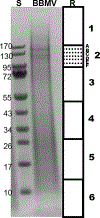N-glycosylation in Spodoptera frugiperda (Lepidoptera: Noctuidae) midgut membrane-bound glycoproteins
- PMID: 32553552
- PMCID: PMC8130577
- DOI: 10.1016/j.cbpb.2020.110464
N-glycosylation in Spodoptera frugiperda (Lepidoptera: Noctuidae) midgut membrane-bound glycoproteins
Abstract
Spodoptera frugiperda is a widely distributed agricultural pest. It has previously been established that glycoproteins in the midgut microvillar membrane of insects are targets for toxins produced by different organisms as well as plant lectins. However, there is still little information about the N-glycome of membrane-bound midgut glycoproteins in Lepidoptera and other insect groups. The present study used mass spectrometry-based approaches to characterize the N-glycoproteins present in the midgut cell microvilli of Spodoptera frugiperda. We subjected midgut cell microvilli proteins to proteolytic digestion and enriched the resulting glycopeptides prior to analysis. We also performed endoglycosidase release of N-glycans in the presence of H218O determining the compositions of released N-glycans by MALDI-TOF MS analysis and established the occupancy of the potential N-glycosylation sites. We report here a total of 160 glycopeptides, representing 25 N-glycan compositions associated with 70 sites on 35 glycoproteins. Glycan compositions consistent with oligomannose, paucimannose and complex/hybrid N-glycans represent 35, 30 and 35% of the observed glycans, respectively. The two most common N-glycan compositions were the complex/hybrid Hex3HexNAc4dHex4 and the paucimannose structure that contains only the doubly-fucosylated trimannosylchitobiose core Hex3HexNAc2dHex2, each appearing in 22 occupied sites (13.8%). These findings enlighten aspects of the glycobiology of lepidopteran midgut microvilli.
Keywords: Aminopeptidase N; Glycoproteins; Glycoproteomics; Midgut microvillar membrane; Spodoptera frugiperda; Transferrin.
Copyright © 2020 Elsevier Inc. All rights reserved.
Conflict of interest statement
Declaration of Competing Interest The authors declare that they have no known competing financial interests or personal relationships that could have appeared to influence the work reported in this paper.
Figures






Similar articles
-
Detergent-resistant domains in Spodoptera frugiperda midgut microvillar membranes and their relation to microapocrine secretion.Comp Biochem Physiol B Biochem Mol Biol. 2019 Sep;235:8-18. doi: 10.1016/j.cbpb.2019.05.008. Epub 2019 May 24. Comp Biochem Physiol B Biochem Mol Biol. 2019. PMID: 31129292
-
The peritrophic membrane of Spodoptera frugiperda: secretion of peritrophins and role in immobilization and recycling digestive enzymes.Arch Insect Biochem Physiol. 2001 Jun;47(2):62-75. doi: 10.1002/arch.1037. Arch Insect Biochem Physiol. 2001. PMID: 11376453
-
Identification of midgut microvillar proteins from Tenebrio molitor and Spodoptera frugiperda by cDNA library screenings with antibodies.J Insect Physiol. 2007 Nov;53(11):1112-24. doi: 10.1016/j.jinsphys.2007.06.007. Epub 2007 Jun 17. J Insect Physiol. 2007. PMID: 17644107
-
Mass Spectrometry-Based Chemical and Enzymatic Methods for Global Analysis of Protein Glycosylation.Acc Chem Res. 2018 Aug 21;51(8):1796-1806. doi: 10.1021/acs.accounts.8b00200. Epub 2018 Jul 16. Acc Chem Res. 2018. PMID: 30011186 Free PMC article. Review.
-
Advances in mass spectrometry driven O-glycoproteomics.Biochim Biophys Acta. 2015 Jan;1850(1):33-42. doi: 10.1016/j.bbagen.2014.09.026. Epub 2014 Oct 2. Biochim Biophys Acta. 2015. PMID: 25284204 Review.
Cited by
-
The role of glycoconjugates as receptors for insecticidal proteins.FEMS Microbiol Rev. 2023 Jul 5;47(4):fuad026. doi: 10.1093/femsre/fuad026. FEMS Microbiol Rev. 2023. PMID: 37279443 Free PMC article. Review.
References
-
- Aertgeerts K, Ye S, Tennant MG, Kraus ML, Rogers J, Sang BC, Skene RJ, Webb DR & Prasad GS (2004b) Crystal structure of human dipeptidyl peptidase IV in complex with a decapeptide reveals details on substrate specificity and tetrahedral intermediate formation. Protein Science, 13(2), 412–421. - PMC - PubMed
-
- Bartfeld NS & Law JH (1990) ISOLATION AND MOLECULAR-CLONING OF TRANSFERRIN FROM THE TOBACCO HORNWORM, MANDUCA-SEXTA - SEQUENCE SIMILARITY TO THE VERTEBRATE TRANSFERRINS. Journal of Biological Chemistry, 265(35), 21684–21691. - PubMed
-
- Beerntsen BT, Severson DW & Christensen BM (1994) AEDES-AEGYPTI - CHARACTERIZATION OF A HEMOLYMPH POLYPEPTIDE EXPRESSED DURING MELANOTIC ENCAPSULATION OF FILARIAL WORMS. Experimental Parasitology, 79(3), 312–321. - PubMed
-
- Bergfussman A, Grace ME, Ioannou Y & Grabowski GA (1993) HUMAN ACID BETA-GLUCOSIDASE - N-GLYCOSYLATION SITE OCCUPANCY AND THE EFFECT OF GLYCOSYLATION ON ENZYMATIC-ACTIVITY. Journal of Biological Chemistry, 268(20), 14861–14866. - PubMed
MeSH terms
Substances
Grants and funding
LinkOut - more resources
Full Text Sources
Other Literature Sources

